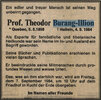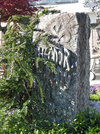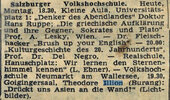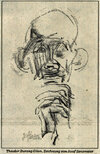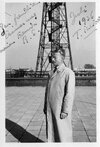Ich sehe ihn gehen. Vielleicht war es dies, als ich anfing, mir von ihm ein Bild zu machen. Vor dreißig, fünfunddreißig Jahren habe ich den Mann zum ersten Mal gehen sehen. Ich weiß nicht, war es Sommer oder Winter, aber ich bin sicher, er ging im Mantel, in der Hand eine bauchige Aktentasche. Am Kopf saß ihm eine Mütze, die er nicht schräg wie eine Baskenmütze aufhatte, er trug sie aufrecht, mit hochgestellter Stirnborte. Man mochte die Kopfbedeckung auf solche Art lächerlich unmodisch finden, sie schuf Distanz; sie war wie ein Barett oder gar ein Herzogshut. Ich erinnere mich auch, daß es immer die gleichen abgetragenen, staubigen Epitheta waren, mit denen er einherging - Mantel, Mütze, Tasche. Zuletzt, seit er, ein wenig schleifend, den Gang verlangsamen mußte, kam der Stock hinzu. Aber ein Mann von über achtzig, da zählt der Stock nicht als Besonderheit, auf die man sieht. Umso mehr war das bei Herrn Illion das Auge; ein Auge wie das eines Jünglings, die Helligkeit der Pupille mit dem lebhaften Spiel ringsum, einem Kinderspiel von Fältchen, die sich über das Alter lustig machten. Hatte er dies nicht lange voraus gewußt?
In einem ersten Buch über Tibet, das Dach der Welt, das er als Sechsunddreißigjähriger kühn und seelenruhig im Alleingang durchwandert hatte, pries er die Einsiedler mit ihren "Jünglingsherzen und der Weisheit eines alten Mannes". Dazu beschrieb er das Gegenbild, denn er hatte es auch dort bei der größten Mehrzahl angetroffen: jene, die ,,sehr schnell das herrlichste - ihre Jugend - verschleudern, und wenn sie einmal älter geworden sind und Erfahrungen gesammelt haben, haben diese keinen Wert mehr, weil in der Zwischenzeit ihre Herzen Stein geworden sind".
Dieser Satz aus dem Buch ,,Rätselhaftes Tibet", 1936 in Hamburg erschienen, mag uns die Einbegleitung sein. Denn ich wage den Versuch, der langen Lebenswanderung eines Weisen, den ich kannte und nicht kannte, von ferne, scheu, mit Schritten wie ein Zaunkönig, zu folgen. Und wer wüßte nicht die wahre Vergeblichkeit des Schritthaltens, sei es auch, wie hier, in der Spur des Humors von dem Vorausgegangenen, die der Tod nicht verweht hat. Ich hoffe nur, ich würde Hern Illion, ohne daß er meiner Not widerspräche, lachen hören. Sein Lachen, das wie der Sprechton im Eifer der Rede die Lage wechseln konnte gleich dem Stimmbruch an der Schwelle des Jüngling salters.
Auch das Raunen erinnere ich, ein Flüstern plötzlich, wenn das Gespräch an Sachen rührte, denen seine Sorge galt oder auf die er Hoffnung setzte. Das laute Wort schien ihm die innere Kraft zu schmälern. Ein begeisternder Gedanke aber war genug: die Stimme kehrte ihm zurück, die Augen fingen an, Silbe für Silbe leuchtend mitzusprechen. Oft nahmen dann die pralle Ziehharmonika seiner Wandertasche in den Griff, um ein Schriftstück ans Licht zu holen. Da war es der mahnende Brief, an einen Staatsmann gerichtet, auch dessen Antwort an ihn ,,...postlagernd Salzburg/Hauptbahnhof". Oder einer der mehrsprachig gedruckten Artikel aus seiner Feder: Biafra betreffend, Nigeria, Pakistan, Indien; einen Teil dieser ganzen heillosen kriegerischen Welt und ihrer Geplagten, denen er, ein einzelner ohne feste Adresse, mit gleichmäßig weitausholenden Schritten, so wie er zu gehen gewohnt war, die Saat der Wahrheit zubrachte.
Während ich dies schreibe, kommen mich Zweifel an. Ich glaube zu wissen, was statistisch an überprüfbaren Erfolgen humanitären Engagements für den Stand der Dinge abfällt. Hat Herr Illion in seiner Tasche nicht in Wirklichkeit Steine gesammelt? Geistige Inhalte, welche er ungebeten, uneigennützig und stetig hingab, ohne den Weg der Versteinerung zu kalkulieren, den sie gingen, ohne den Enderfolg abzuschätzen? Trug er nicht fern und immer ferner von jedem Vorteil, je älter er wurde desto schwerer, mit sich herum, was für ihn alles war und nichts: Omnia mea mecum porto -?
Aber da ist wieder das Wissen des Zaunkönigs, das kleinweis erfaßbare Futter meiner Kenntnisse: Ich schrumpfe in mich zusammen, Schritt um Schritt übersteigt mich der Schatten des Gehenden mit seinem Wandergepäck, mit dem tibetanischen Ein-Mann-Zelt damals und der kalten Nahrung der Körner, dem frierenden Wassertrunk, dem Kokon der nicht zu wechselnden Kleider, aus denen kein Haben, aber das wahre Sein sich entpuppen konnte. Denn da lese ich bei dem noch nicht Vierzigjährigen, der sich ,,T. Illion” nannte:
,,Warum gelingt es nicht den paar hundert Männern, die als wahre Einsiedler oder Heilige leben, Tibet zu ändern? Es gelingt ihnen nicht, weil die Masse der Tibetaner betrogen werden will. Sie ziehen die Leute, die ihnen Pillen oder Zauberschuhe verabreichen, denen vor, die ihnen in uneigennütziger Weise Wahrheit geben … Die wenigen weisen Tibetaner haben nichts zu verkaufen … Weisheit ist überall für diejenigen, die ,Augen haben, um zu sehen, und Ohren, um zu hören’. Weisheit ist wie eine schöne Blume am Wegesrand. Sie ist nicht unsere eigene Weisheit und auch nicht die Weisheit unseres Nachbarn. Wenn wir die Blume pflücken, so gehört sie zwar uns, aber sie ist tot. Man kann seine eigene Gelehrsamkeit besitzen, nicht aber seine eigene Weisheit. Dem Gelehrten sind viele Dinge verschlossen, dem Weisen ist alles klar.”
An anderer Stelle liest man die radikale, von der Wurzel her angesprochene Verneinung des Vorteils unter dem Schild des Intellektualismus, denn es ist die eine, durch nichts tilgbare Sünde wider den Geist: ,,Im wahren Geistigen gibt es keinen, Vorteil’ … Die Einsiedler wissen, daß alle Übel der Welt auf die grenzenlose Ichsucht des einzelnen zurückzuführen sind.” Deshalb wollen diese tibetischen Männer gar nicht allen und jedem ,,direkte Hilfe leisten”; vielmehr wollten sie ,,denjenigen, die sie überhaupt verstehen können, das richtige Leben vorleben, welches weder Disharmonie noch Leiden schafft. Wenn sich andere aber durch ihr Beispiel nicht beeinflussen lassen, gehen sie ruhig ihren Weg.”
Stellt man solcher Aussage das Lebensbild des Sechzig- und des weit über Achtzigjährigen gegenüber, das Jüngeren, wie auch mir, bei Begegnungen mit dem schreibenden, vortragenden, in Gesprächen sich mitteilenden Theodor Burang-Illion aufgegangen ist, so macht es ein Phänomen von kaum je gesehener Dekkungsgleichheit erkennbar, wie es sonst nur im spirituellen Leben vorkommt: Zwischen dem Autor und seinem Gegenstand, genauer, jenen Zielgestalten der wagemutig asketischen Fußreise, welche er die ,,wahren Einsiedler”, die ,,Heiligen” nannte, und ihm selbst, Herrn Illion, hat ein unaufhörlicher Assimilierungsprozeß im Geistigen stattgefunden.
Ich habe mir über diesen bewegenden subjektiven Eindruck Rechenschaft zu geben versucht. Ich fragte Personen aus dem mir nur vereinzelt namhaft gewordenen Kreise derer, die den Urheber solcher Gedanken näher gekannt haben mochten. Dabei aber verengte sich der Kreis erst von neuem. Jeder vermeinte, ein anderer hätte mehr über ihn wissen müssen, die Bekanntschaft des anderer hätte länger gewährt.
So blieb unwiderrufen jene frühe Buchquelle der lebendigste Aufschluß auch zur Biographie. Er erwies die tibetanische Erkundung des jungen Forschers T. Illion als die Erkundung seiner selbst; als den Ort tiefer Einsicht in eine spiegelgleiche Seinslehre. Diese kennt nicht ,,die Trennungslinie zwischen dem Ich und dem Nicht-Ich”’ welche der eigensüchtige Mensch zieht. Für den Wanderer durch Tibet war das Leben der Einsiedler die Bestärkung für das eigene Leben, wie er es jetzt und künftig führen wollte. Seine Aufzeichnungen machen das offenbar;
Nirgends spricht aus ihnen die Überraschung. welche einem Entdecker dabei hätte widerfahren müssen; sie verraten die Genugtuung dessen, der die erwarteten Schätze glücklich auffand, dort, wo er sie suchte. Er hat sie auf seinem langen Weg als ein Geheimnis von ,,ewiger Jugend” mit sich geführt bis ins neunte Lebensjahrzehnt; schweigend, wenn es über unvermeidbare ,,Hängebrücken” ging, auf denen er niemanden neben sich haben wollte, wie schon in Tibet, wo er gelernt hatte, ,,überflüssigen Gesprächen beim Hinübergehen” auszuweichen.
Ich selbst habe das einen unvergeßlichen Moment lang mit ihm erlebt. Er ging neben mir von einem offenen Grabe weg, und sein Schweigen dauerte dann zehn Schritte länger fort, als ich selbst es zu halten verstand. Wie froh war ich, da das Gespräch zwischen uns sich so entwickelte wie immer, als wäre die verweilende Besinnung seines Ich im zeitlosen Nicht-Ich von mir nicht gestört worden. Tage danach las ich in Herrn Illions erstem Tibet-Buch einen Absatz, den er über einen Mann geschrieben hatte, dessen zugleich ,,selbstlose und unpersönliche Güte” ihn tief berührte. Er nennt sie ,,eine Güte der Stärke, nicht der Schwäche” und erzählt, wie ihm geschah:
,,Wir gingen nebeneinander her, und er begann seine Schritte zu beschleunigen. Ich tat dasselbe. Ich kann bis zu neun Kilometern in der Stunde zurücklegen, ohne zu laufen, aber der tibetanische Nalliorpa ging schneller. Plötzlich wurde mir klar, daß er jetzt wünschte alleingelassen zu werden. Ich blieb einen Augenblick stehen und wandte mich ab. Als ich mich wieder umwandte, war er nicht mehr zu sehen.”
Dieses Allein-sein-Wollen: so pünktlich Herr Illion war - es hieß, man konnte die Uhr nach ihm richten bei seiner absoluten Verläßlichkeit - so war wie das Kommen auch der Augenblick des Gehens, wie es schien, vorausbestimmt. (Ein Grund, weshalb er seine Tagereisen im weglosen Tibet durch kein saumseliges Tragtier behindern lassen wollte.) Herr Illion hatte aber eine besondere Zeit des Alleinseins, die er sich auf seine Weise zur Regel machte. Es war immer zu Weihnachten, daß er, mehr noch als sonst, der Welt abhanden kam. Auch in den späteren Jahren, während er sich als bescheidener Mieter dort oder da in kleinen Privatzimmern aufhielt, nahm er vor dem 24ten in einem Wirtshaus Quartier. All die Jahre schon hatte er in einem halben Dutzend Dörfern zwischen Tauern und Salzkammergut, als ein harmlos fremdartiger Nomade in Gasthäusern wohnend, Schreib- und Studierstube dort aufgeschlagen. Zu Weihnachten also lebte er auch jetzt ohne erreichbare Adresse. Niemand konnte ihm zur Gesellschaft dienen; von niemandem nahm er ein Zeichen; keine Post kam zu ihm. Die innere Stille des Einsiedlers war unteilbar. Mag sein, daß ihm an diesen Tagen der Abgeschlossenheit - unbewußt, ungewollt - die Geistesruhe so zu atmen erlaubte, wie er es gut fand: im Rhythmus der Entspanntheit von Seele und Körper. ‘’Ich atme auch im Abendland nur etwa dreimal in der Minute”, hatte er lange Jahrzehnte vorher in jenem Tibet-Buch notiert.
Burang-Illion, der in seiner Jugend in Japan eine Weile Medizin studierte, dann aber den Quellen tibetanischer Heilkunst nachging - seine Bücher, Schriften und Vorträge zeugen vom geistigen Erträgnis -, hat sich im letzten Lebensjahrzehnt von neuem und ganz den Gedanken dieser Disziplin zugewandt. Im Briefwechsel mit Ärzten in aller Welt lenkte er die Orientierung auf eine psychosomatische Medizin hin und führte jüngere Kräfte als Adepten tibetischer Lehren in die originalen Texte ein.
Forschung und Wegweisung waren seit jeher seine selbstlosen Dienste, zumal für junge Menschen, gewesen. Schulen in Land und Stadt sahen ihn als ihren willkommenen Gast. Nicht kalter Intellekt, sondern Kopf und Herz bestimmten sein Tun. Weisheit erlangen bedeutete, daß ,,das Herz sich änderte”. Er lehrte: ,,Nicht Kenntnisse anhäufen wei ein Geizhals, der Gold aufspeichert.” Die Konsequenz seines medizinischen Denkens: ,,Nicht Ichsüchtige heilen, sie würden wieder mit den Ausschweifungen anfangen, die sie vorher krank gemacht haben.”
Für sein Buch ,,Der Arzt in der tibetanischen Kultur” bildet der fundamentale Schlußsatz den Brückenschlag zu einer ,,neuen Heilkunde, die weder spezifisch östlich noch westlich ist”, wenn er sagt: ,,Dies dürfte nicht nur vom guten Willen, der Geschicklichkeit und der Gelehrsamkeit einzelner abhängen, sondern auch davon, ob eine in Leid und Sünden verstrickte Menschheit die Wege zu einer geistig-seelischen Neuordnung einzuschlagen gewillt ist.”
Dennoch fühlte er sich ,,eins mit allen Freuden und Leiden der Welt”. Und dies frei von der leisesten Selbsttäuschung, daß es erlaubt sei, dabei glücklich zu sein. Sein Frohsinn, sein fabulierender Witz (in kleinen Theaterstücken für junge Leute), seine jugendlich Begeisterungsfähigkeit, die Ausstrahlung von Friedsamkeit und das vorurteilslose Hören, wer immer da zu ihm sprach (ausgenommen die Sprache des Fanatismus): das zählte ihm wohl als das gerechte kleine Glück, das man haben durfte. So wie ihm seine Fußmärsche ¨ber Berg und Tal ,,einen wunderbaren Sonnenuntergang” ansehen ließen, oder wie man “eine herrliche Musik” vernimmt, und will sie doch nicht nehmen, nicht besitzen. ,,Es ist die Glückseligkeit vollkommener Selbstlosigkeit, die auch keine Belohnung für Selbstlosigkeit erwartet…”
Wer war dieser Mensch, dessen beide Namen - Burang,, Illion - so gewiß wie ungewiß die Namen seiner Geburt gewesen sein mögen? ,,Ein Tibeter”, meinte jemand, ,,der anderswo auf die Welt gekommen ist?” Asiatische und europäische Sprachen standen ihm im Dutzend zu Gebot; er war ein Meister des Französischen, in dem er seine Sketches zu schreiben beliebte. Diese zeigten den Ironiker Illion. Genüßlich und vorzugsweise behandelte er darin alles Autoritative, alles dümmliche Übermenschentum von Staatsdienern, indem er es gleichsam in tibetanischer Butter so naiv wie ranzig herausstrich; er, der das ,,verbotene Land” damals fast ein Jahr lang - mit jodgelber Schminke auf Gesicht, Kopfhaut und Händen - unerkannt als Weißer durchstreift hatte; der alles Papierzubehör des Menschen auch mitten im Abendland als reiner Tor an sich vermissen ließ. “Meinen Sie nicht, es genügt zu wissen, daß ich ein Mensch bin?” hat er die freundliche Frage nach seiner Herkunft einmal freundlich zurückgewiesen. (Es war nicht ein Beamter, der sie gestallt hatte.) Herrn Illions Paß enthüllte nichts von einem speziellen Nationale. In seiner allgemeinen Bedürfnislosigkeit hatte er sich auf das Doppelwesen von Staatsbürgerschaften nirgendwo eingelassen.
Auf seinem Totenschein stand: Geboren am 5. Mai 1898 in Quebec, Canada. Gestorben in Hallein, am 4. September 1984. Theodoe Burang-Illion war nahe dem Postamt von Puch (obzwar dieses seit seinem Verzug schon Jahre nicht mehr das ,,zuständige” war) auf dem Gehsteig neben einem Gartenzaun zusammengesunken. Der Stock kollerte hin, die Tasche, ,,sein tragbares Besitztum, samt der empfangenen Post - glitt herrenlos zu Boden. Der Arzt, der ihn von einer Berghütte aus langen Gesprächen gekannt hatte (,,Seine Finger waren wie Fühler, sehnig und sensibel für Naturphänomene.”), trat Minuten danach zu ihm. Der Krankenwagen kam. Der Spitalsbefund bestätigte, daß der Eingelieferte klinisch tot war. Nur das Herz nahm sich noch Zeit, fünf Tage und fünf Nächte zu schlagen. Das seelenruhige Herz des Wanderers. Sein Grab liegt in dem von Bergen umgebenen Dorf Kuchl. Der in benachbarter Gegend lebende Bildhauer Josef Zenzmaier, einer aus dem Kreise derer, die ihn näher kannten, will im Frühjahr die Stele für das Ruhende von Herrn Illion schaffen. Dieser selbst hatte zu Denkmalen der Pietät ein gewissermaßen vertrauliches Verhältnis gehabt. Nicht nur, daß der Unseßhafte am Allerseelenfest der kirchlichen Gemeinden jenen Friedhof mit Grablichten aufsuchte, der Stätten seiner eigenen Erinnerung barg; mit allem Vergnügen erzählte er eine Guttat, die ihm im Salzberger ,,Kommunalfriedhof” geglückt sei. Dort stehe an einem Grab eine hohe Fichte, die eigentlich (leise gesagt) nicht dirt stehen dürfte. Es ist das Grab eines verunglückten Bergsteigers. Ihm hatte er damals das Pflänzchen eines Nadelbaumes zu Häupten gesetzt. Es ist seither mächtig emporgeschossen. Herr Illion flüstert von zwanzig Metern. Dazu das innige Gefühl von Gerechtigkeit: ,,Ich habe da den Autoritäten der Friedhofsverwaltung ein schönes Schnippchen geschlagen.” Pietät, Humor, eine seltsam naive Ironie und zugleich das poetische Spiel mit Metaphern aus dem Bild der Nature…
Wer war er, der es uns genug sein ließ, ihn als Menschen zu erkennen? Von angelsächsich-schwedischer Abstammung, Sohn einer Aristokratenfamilie im französisch-sprachigen Canada: Zu jemandem hatte er bemerkt, er wäre mit zwölf Jahren von Zuhause fortgelaufen und nach Japan gereist. Den Akt der Trennung vollführte endgültig die Geste eines Wurfs: das nobel Geschenk eines silberbeschlagenen Spazierstocks flog dem Knaben aus der Hand - er ließ es in weitem Bogen auf das dahinströmende Wasser des St Lawrence River klatschen. Nichts mehr von den Dingen, die einem flauen, leeren, reichen Leben zugehörten!
Viel weiter zurück in der ungeschriebenen, unausgesprochenen Geschichte einer Abkunft tauchte irgendeinmal, hingesagt zwischen einem tibetanischen Lächeln und einem Achselzucken, der britannische Königsname der Plantagenets auf. Ein jüngerer Freund grub in London eine Weile in Bibliotheken und schaute bei historischen Bildnissen nach. Er ließ mich wissen, es sei ,,die unglaublichste Ähnlichkeit” bei einem Henry V in der National Portrait Gallery. Wenn man nachliest: dieser ,,Heinrich” schneidet bei Shakespeare auf der Bühne der Könige als der beste des Geschlechtes ab. ,,His liberal eye doth give to every one…”

